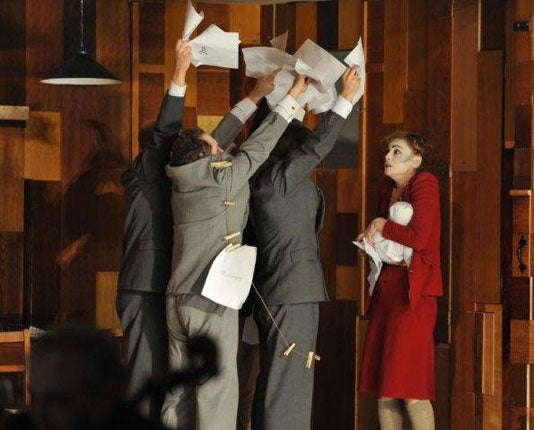Rumpelstiltskin / BCMG, Bates Mill, Huddersfield
A magical spin on a Grimm tale

Your support helps us to tell the story
From reproductive rights to climate change to Big Tech, The Independent is on the ground when the story is developing. Whether it's investigating the financials of Elon Musk's pro-Trump PAC or producing our latest documentary, 'The A Word', which shines a light on the American women fighting for reproductive rights, we know how important it is to parse out the facts from the messaging.
At such a critical moment in US history, we need reporters on the ground. Your donation allows us to keep sending journalists to speak to both sides of the story.
The Independent is trusted by Americans across the entire political spectrum. And unlike many other quality news outlets, we choose not to lock Americans out of our reporting and analysis with paywalls. We believe quality journalism should be available to everyone, paid for by those who can afford it.
Your support makes all the difference.Much more than just music describing a story, and a far cry from Disney's Fantasia, David Sawer's enthralling new music-mime piece, Rumpelstiltskin, is a cross between a short narrative ballet and a silent movie with a striking live soundtrack. In choosing to illustrate this particular Grimm Brothers' fable, in which a miller's idle boast that his daughter can spin straw into gold sets in motion a thread of catastrophic consequences, Sawer has himself struck gold.
In Rumpelstiltskin, presented as part of the Huddersfield Contemporary Music Festival, the musical tapestry of evocative and often tongue-in-cheek sounds conjures vivid stage pictures even without the deft gestures of the six dancers. Fortunately, since there are no words threading the pieces of the tale together, these performers can act as well as they can move. Best of all is Lucy Burge's bizarre, Rasputin-like Rumpelstiltskin who, chuntering dementedly to herself, repeatedly saves the miller's daughter but is in the end cheated of her promised reward of the girl's first child. Bryony Perkins blossoms from exploited girl to feisty Queen, her initial desperation turning to sneering triumph as she defeats Rumpelstiltskin. The dancers' expressive body language, as they flip from scene to scene inside and around Stewart Laing's versatile wooden cube set, makes the need for any spoken narrative redundant.
Though Sawer conceived Rumpelstiltskin as a piece for the concert hall – with the costumed instrumentalists set alongside the dancer-actors, and often criss-crossing the performance space – it would be easier to focus on his colourful and well-crafted score without the distraction of seeing the players. Watch the conductor Martyn Brabbins weave magical sounds from the 13-strong Birmingham Contemporary Music Group and you risk missing some vital dramatic nuance in Richard Jones's minutely-detailed direction and picturesque characterisation. Sawer's score is sombrely dark in the dungeon scene, jubilant in its evocation of wedding bells and elegantly lyrical in its depiction of its 20th-century, Mid-European setting. There may be too many puzzles woven into its texture to take in at first hearing, but the music is immediate in impact, apparently meticulously prepared and perceptively performed.
Flute, oboe and clarinet tangle acerbically together, while violin, viola and cello give emotional depth. Bass clarinet, horn and trumpet contribute a mellow richness and bassoon, tuba and double bass add fearful grimaces. The harp glitters on the fringes of these distinctive groups.
The King's gold slippers and Rumpelstiltskin's coin, nugget and, finally, ingots of gold, gleam among the dowdy costumes of muted colours. It was impossible not to feel the pain and humiliation in Rumpelstiltskin's final reel, as Burge flailed, in tandem with an increasingly unhinged mental state. The ghastly denouement was entirely in-keeping with the Grimm Brothers' reputation for the gory and the grotesque.
Join our commenting forum
Join thought-provoking conversations, follow other Independent readers and see their replies
Comments